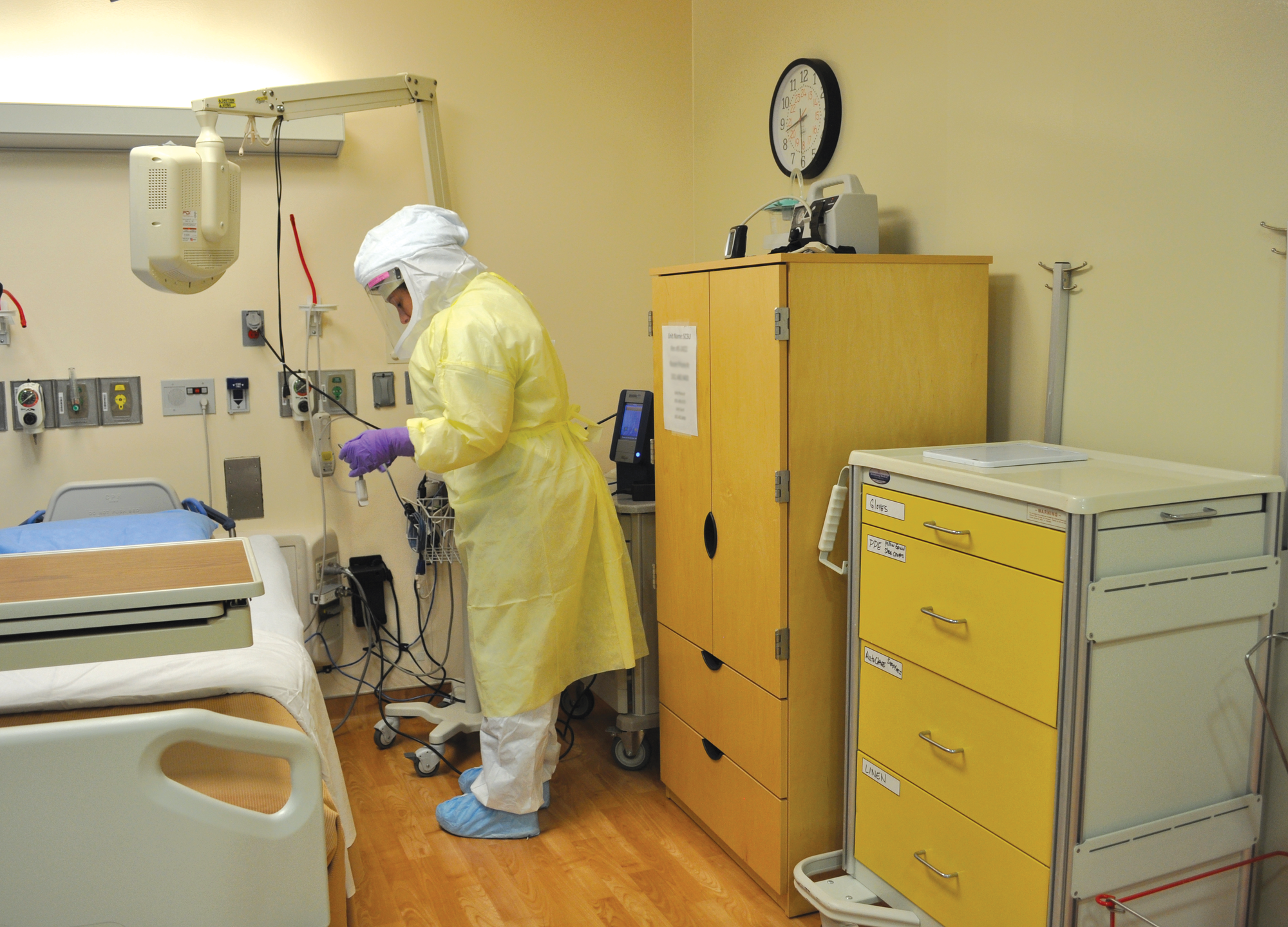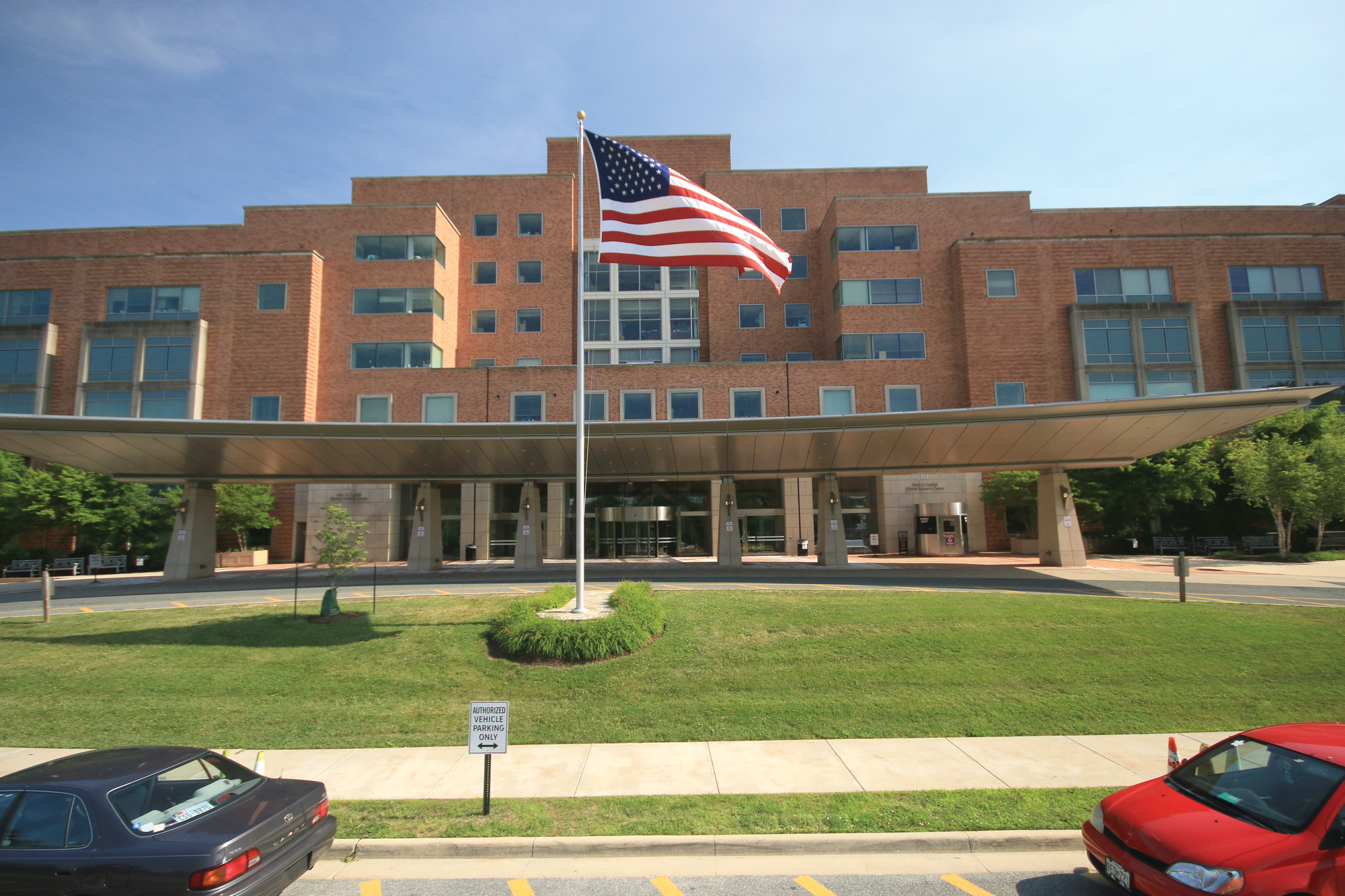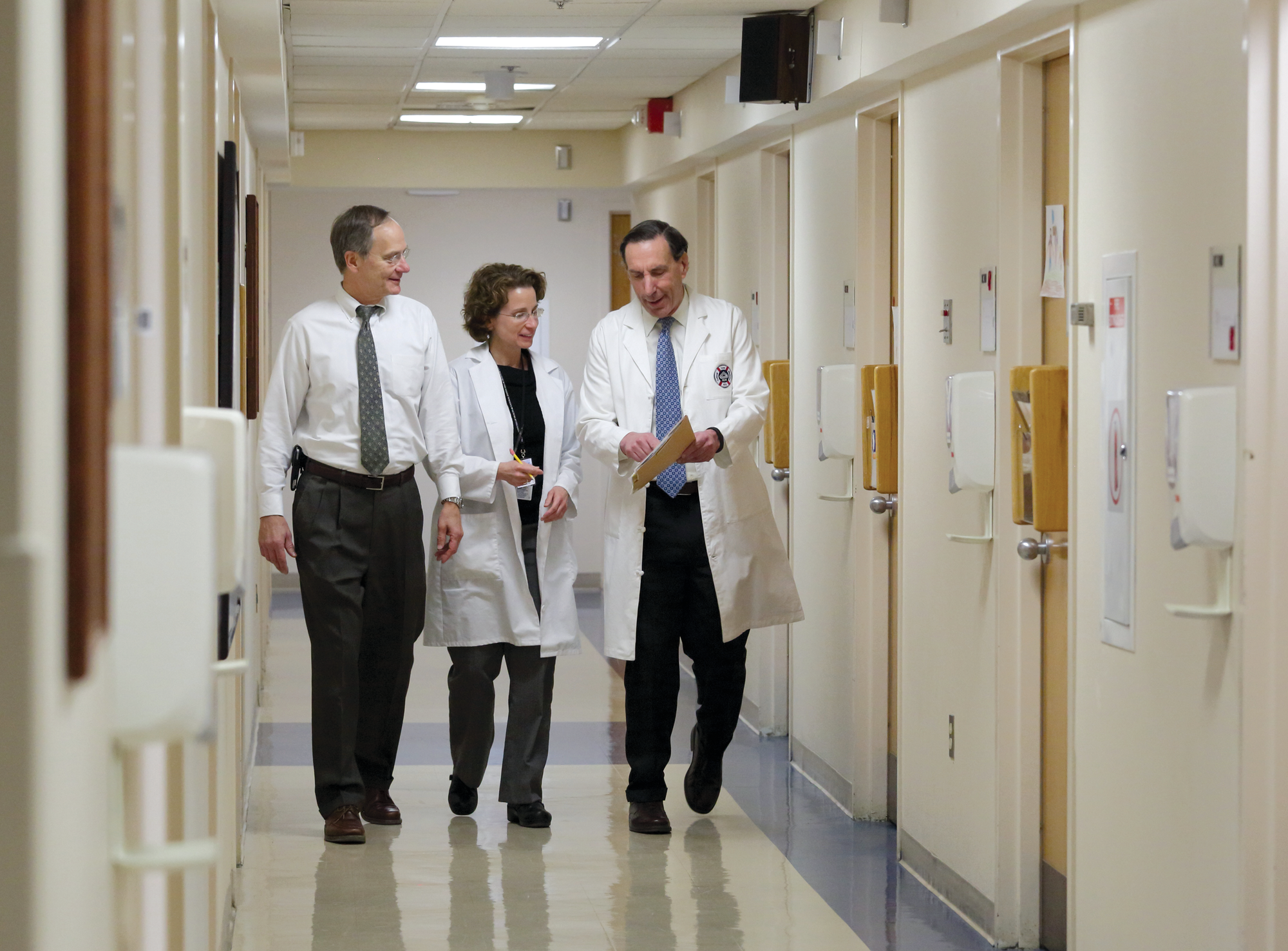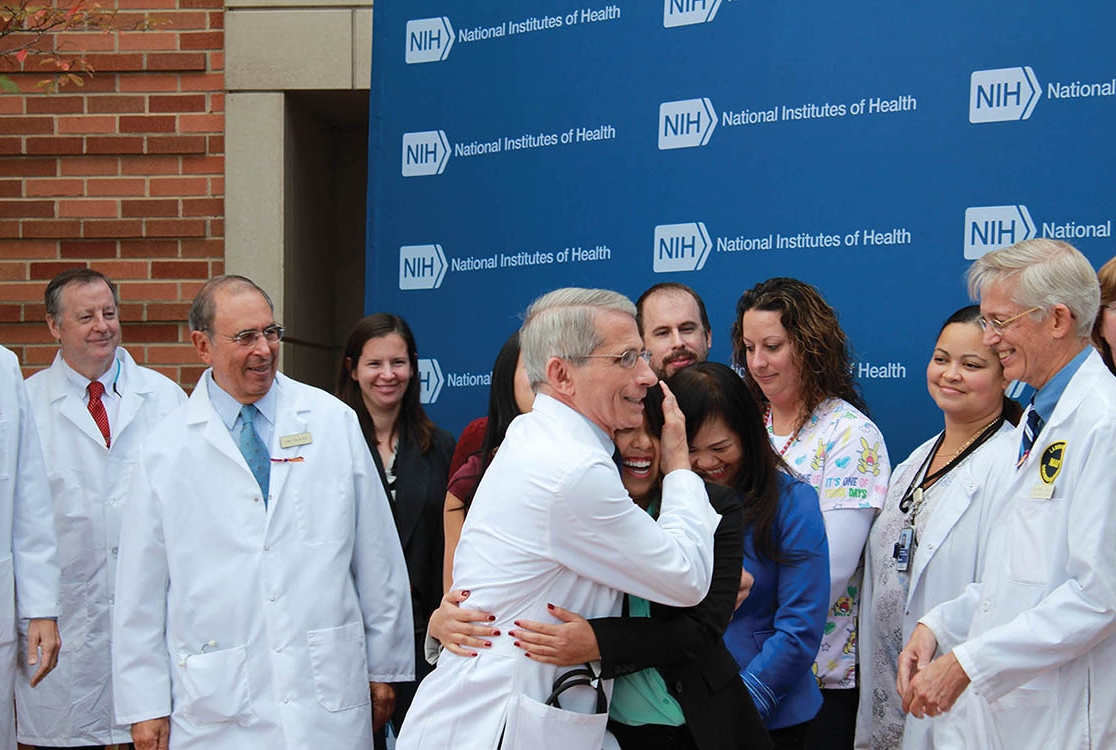Last fall, all eyes were on the National Institutes of Health's Clinical Center in Bethesda, where a nurse with Ebola was being treated. Meet the Weill Cornell Medicine alumni who lead it
By Beth Saulnier
"This may not look like much," says Dr. John Gallin, '69, "but this the most high-containment facility in the country — probably in the world."
Dr. Gallin is standing in what appears, more or less, to be a conventional patient room: hospital bed; adjacent bathroom; institutional furniture; Web-enabled TV on a telescoping arm; sockets on the walls for attaching monitors and other equipment. But behind the scenes, the facility is extraordinary.
Negative pressure and heavy doors prevent air from flowing out from the patient room before it goes through a specialized filtering system. Nearby autoclaves, installed at a cost of $1 million, sanitize protective clothing, which is later incinerated. An anteroom just steps from the bed offers a window through which designated monitors can observe, insuring that staff follow infection-control procedures to the letter. On shelves in the hallway are stacked the constituent parts — including face shields and battery-powered respirators — for the "space suits" that have become cultural signifiers in the battle against virulent infectious diseases. This is the Special Clinical Studies Unit — no ordinary facility, in a building that's no ordinary hospital. The unit is located in the Clinical Center at the National Institutes of Health in Bethesda, Md.; Dr. Gallin is the center's director.

Dr. John Gallin. Photo Credit: Rhoda Baer
Last October, the SCSU was home to the woman who was arguably the most famous patient in the country: Nina Pham, the Texas nurse who contracted Ebola in the line of duty. All eyes were on the Clinical Center, with TV news trucks lined up on the roadway outside; through the large windows in his sixth-floor office, Dr. Gallin had a birds-eye view of the media scrum parked outside. "I had Nina Pham's mother in my office, and she wasn't really aware at the time of what a big deal this was," Dr. Gallin recalls. "She looked out and asked, 'Why are all those things here?' and I said, 'For your daughter.' That blew her away."
The Ebola case was just one moment — albeit a dramatic one — in Dr. Gallin's long career at the NIH. He has worked there since 1971, save for a stint when he returned to Bellevue (where he did his residency) to serve as senior chief resident in medicine. And he's not alone; a number of Weill Cornell Medicine alumni have had long careers at the Clinical Center and its related institutes. They include the physician who became the face of the government's response to Ebola, as he had for HIV/AIDS a generation earlier: Dr. Anthony Fauci, '66, director of the National Institute of Allergy and Infectious Diseases.
Dr. Gallin worked across the hall from Dr. Fauci in the early '80s, when the first of what would later be identified as AIDS cases appeared in the Centers for Disease Control and Prevention's Morbidity and Mortality Weekly Report. The episode, Dr. Gallin says, exemplifies the appeal of working at the NIH. "We were chatting in the hallway, and Tony said, 'I'm in the perfect position to study this. This is going to be a real problem,'" Dr. Gallin recalls. "This was the second week that it became public. He had that incredible foresight." Turning on a dime, Dr. Fauci — who'd had great success in the use of chemotherapy agents in non-cancer diseases — refocused his lab to work on HIV/AIDS. "The point I'm making is not that he's terrific, although he is," Dr. Gallin says. "It's that he could do it. He could change. And when Ebola came, we could change. If something else comes, we will be able to respond to it."
Physician-scientists and Ph.D. researchers in the NIH's intramural program — meaning those who work on the Bethesda campus, rather than investigators at other institutions receiving NIH grants — operate under a fundamentally different funding structure from colleagues elsewhere in academic medicine. Rather than applying for grants to support future work, they receive funding based on a four-year review of their past productivity. "As everyone knows, it's a tough environment for investigators, and it's competitive. You have to rely on multiple sources of funding, and if you've got a clinical burden as well, it can be a real challenge," says Dr. Fred Ognibene, '79, the Clinical Center's deputy director of educational affairs and strategic partnerships. "Nothing is ever easy or guaranteed, but at least things are a little easier here, given the nature of our business."
As Dr. Gallin points out, he and his colleagues aren't wedded to a particular project and can follow an interest wherever it may lead them — or switch to concentrate on an emerging crisis, as Dr. Fauci did. "Here, if you have a good idea, that idea will generally carry the day, and you will develop collaborations because people can be flexible," says Dr. Henry Masur, '72, chief of critical care medicine at the Clinical Center. "They're not so tied to, 'I got a grant to do X'; they'll go where the opportunities are. This is a place where research is the dominant thing."

Controlled environment: The primary patient room in the Special Clinical Studies Unit, where patients have been treated for Ebola. Courtesy of NIH
The Clinical Center opened in 1953; its original building is now attached to a state-of-the-art, 870,000-square-foot hospital that opened in 2005. Over the past six decades, it has been home to many major discoveries. They include the first use of chemotherapy to cure a solid tumor; a revolution in the treatment of childhood leukemia (which, Dr. Gallin notes, "went from 100 percent lethal to about 90 percent curable"); landmark work in research and treatment of hepatitis; the development of fluoride for cavity prevention; the use of Lithium to treat bipolar disorder; the treatment of Hodgkin's disease with chemotherapy; the development of a diagnostic test for AIDS and of AZT, its first therapy; and the creation of screening methods to protect the blood supply from HIV and hepatitis. (As Dr. Gallin tells the politicians who regularly visit the center: "This is one of the greatest gifts that Congress ever gave the American public.") Today, the 240-bed facility — where labs and patient rooms are housed under the same roof — is home to nearly 1,530 active research protocols. "We're here for discovery; that's the primary reason," Dr. Gallin says. "Congress gives us money to discover new drugs, new devices, better preventives and treatments. So you can practice medicine here like you can't anywhere else, because we have the luxury of time. We can easily spend an hour with a single patient over and over again to understand their disease. We can order special tests and do things that you wouldn't do on the outside, because they'd be too expensive. Morale here is high, because of our mission; everything we do is to discover tomorrow's cures and improve the management of patients."
There's another important distinction about the Clinical Center: its patients are all participants in an investigator's ongoing research. And as such, their treatment comes free of charge. "We've never sent a bill, and we're proud of that," Dr. Gallin says. "Every patient who comes to this hospital is a volunteer for one of our studies. To come here, you have to have a problem that matches a protocol."
Dr. Gallin himself is one of the world's experts on chronic granulomatous disease, a rare hereditary disorder in which white blood cells fail to make hydrogen peroxide and bleach, and therefore can't fight off bacteria. His lab has described the disease and the genes involved in it, and devised treatments that have improved its once-grim prognosis, with sufferers dying at an early age. "It used to be considered fatal," he says. "Now, children are growing up." His lab actively follows nearly 300 families with CGD, amounting to two-thirds of the world's patients. All in all, the NIH is studying about 435 cohorts of people with rare diseases from around the world. "The reason we have such emphasis on rare diseases is that, one, it gives these patients hope," Dr. Gallin says. "But the other reason is that they are often windows to understand common diseases." For example, he has found that the muted inflammatory response in CGD patients means that they're protected from atherosclerosis — pointing the way toward a promising new target for heart disease prevention in the wider population. "We're a venue for investigators to take these hypotheses from the bench to the bedside, and from the bedside back to the bench," says Dr. Ognibene. "Just by the convenience of where we're located, there is a free exchange of ideas. We espouse the concept of team science; it's what we say we do, and what we actually do."
Before shifting to academic administration, Dr. Ognibene worked on the pulmonary infectious complications of HIV. He compares his current post to that of a medical school dean of education: He oversees the NIH's extensive clinical educational programs, which range from summer opportunities and clinical electives for med students to fellowships for physicians post-residency. "It's an important training place," Dr. Gallin says. "Many of the leaders in academic medicine in the United States have spent time here as young investigators."
While a research-heavy environment like the NIH isn't the right fit for everyone — and, of course, salaries in private practice are often more tempting — people who thrive at the NIH tend to stick around. Dr. Ognibene has been there since 1982, when he and three other internal medicine residents at what was then New York Hospital (now NewYork-Presbyterian/Weill Cornell Medical Center) were recruited to be the NIH's first clinical fellows in critical care medicine. Another member of that quartet, Dr. Joseph Kovacs, '79, also never left: He's now a senior investigator and head of the AIDS section in the critical care medicine department. "We came here partly due to networking, but there's something special about the NIH, and that's why a lot of us have stayed," says Dr. Kovacs, an expert in Pneumocystis, the form of pneumonia that was an early bellwether of AIDS infection and remains problematic for other immunocompromised patients. "It's a great environment where we have a lot of flexibility. The ability to do research in a place where that's our primary focus, the day-to-day meat and potatoes, is wonderful. The fact that everybody has been here so long tells you that something good is going on."
Dr. Masur, who came to the Clinical Center in 1982 to establish its critical care department and a program in HIV/AIDS, is a second-generation NIH physician: his father, Dr. Jack Masur, '32, had Dr. Gallin's job from 1948–51 and from 1956–69. (The building's auditorium is named in his honor.) They didn't overlap at the NIH; the senior Dr. Masur passed away when his son was a first-year medical student. But Dr. Masur notes with a laugh that he's been there so long that sometimes people conflate them, as when he met a pediatrician colleague at another institution. "He said, 'Isn't your father at NIH? In the '80s I used to make rounds with him on pediatric AIDS.' And I said, 'That wasn't my father — that was me.'"
In his role as head of critical care, Dr. Masur oversees the clinical care of patients and the training of staff who manage highly infectious diseases like Ebola. One elemental part of that process is properly putting on and taking off the protective gear — which involves, among other things, two sets of booties and gloves, tape, a zip-up suit, a hood and visor, a respirator, and a protective gown. Staff must also learn to do familiar procedures like intubation while wearing the bulky gear; use a checklist akin to that of airline pilots; and follow the formal surveillance system, in which some staff are designated solely to observe others. "It's like preparing for a show: every step has to be rehearsed and rehearsed," Dr. Gallin says. "We won't let anybody go into the unit until we're convinced that they know what they're doing."

The exterior of the NIH Clinical Center in Bethesda, Maryland. Courtesy of NIH
The NIH's current expertise in Ebola traces back to the months after 9/11, when anthrax attacks riled an already unsettled nation. President George W. Bush asked Dr. Fauci to help develop a biodefense program to deal with future bioterror attacks — including, he says, "the five Category A agents that we knew from intelligence the Soviet Union had built up supplies of during the Cold War years." To wit: smallpox, tularemia, plague, botulism and the hemorrhagic fevers including Ebola, Lassa and Marburg.
"Congress and the administration gave NIH $1.5 billion in our base budget to do that," Dr. Fauci says. "Since there is no real difference between a deliberate bioterrorist and nature — which can sometimes act like a bioterrorist, such as with outbreaks and epidemics — we said that we would direct our efforts against both naturally and deliberately released microbes." The SCSU, which opened in 2010, was built in part to treat any staff accidentally infected during research, but also as a venue for testing vaccines on healthy volunteers; an Ebola vaccine developed at the NIH is currently having its first field trials in Liberia.
Nina Pham was one of two Dallas nurses who contracted Ebola from a patient, a man who'd traveled to the United States from Liberia and later died. When those cases emerged — the first time that healthcare workers had been infected in the United States rather than abroad — the SCSU was one of just three facilities in the country capable of handling them. "As soon as it became clear in Dallas that they were overwhelmed [caring for Pham], the CDC called us," Dr. Fauci remembers. "They said, 'Tony, can you take this patient?' And I said, 'Put her on a plane. We're ready.'"
But training for an Ebola case is one thing; coping with the logistics of treating a real patient is another matter. The Clinical Center faced a variety of challenges, from the practical — like scheduling the more than two dozen staff needed to cover the SCSU each week, and coping with the commensurate drain on the rest of the hospital — to the emotional, in the form of community fears that far outpaced any actual danger. "Admittedly, there is nothing like actually doing the work," Dr. Masur says. "You learn as you go along. Until you do the real thing, you don't know what all the problems are. Until you have two liters of diarrhea on the floor, you don't really know what it's like to try to clean it up safely." Colleagues at Emory University — which treated several Ebola patients, including Pham's Dallas colleague — had warned them that biomedical waste disposal would be a major undertaking. "With Ebola, there's a certain irrationality," Dr. Masur says. "The contractors who'll handle radioactive material and all sorts of pathogens that are much more hardy wouldn't touch the Ebola stuff. We wound up incinerating a huge amount of it into ash, which can't possibly have any virus in it. But nobody would take that, so we had to make a special arrangement and find a landfill that would. It became a big issue, not because it was a scientific problem or an infection problem, but a political, public awareness issue."

Critical care: Henry Masur, MD ’72 (right), consults with colleagues. Photo Credit: Ernie Branson
And then there was a conundrum with a less concrete solution: quelling the concerns — based far more on fear than on science — of the local community. Some of the staff treating Pham were told that their children were not welcome at daycare. A well-known company, which Dr. Gallin declines to name, cancelled its employees' planned visit to the NIH — even though they were meeting in a building elsewhere on its vast campus. Standing in his office, Dr. Gallin points to a line in the middle distance: a street called Cedar Lane. During Pham's stay, he says, he got a phone call from the principal of a nearby school asking whether students could contract Ebola while traveling on the road, which borders the NIH campus. "We accept risks every day without thinking about it, whether it is driving your car to work or walking across York Avenue," Dr. Fauci muses. "But when a new risk is inserted into our lives — even though it is far less probable than some of the risks we accept — for some strange reason it creates a tremendous amount of anxiety and panic. And when people get panicked, the press reports it — and then when people read it in the press, they become more panicky. It becomes almost a self-propagating hysteria."
That fearful atmosphere sometimes made life difficult for staff — who, for example, had to ask spouses to stay home to mind children banned from preschool. But the challenges also fostered a certain esprit de corps. Says Dr. Gallin: "I think people went from being scared, and maybe a little angry, to being very proud and thinking, Isn't it wonderful to work in a place like this and do the things that we do?" In terms of recruiting staff to work with Ebola patients, Dr. Masur reports that the advice of an Emory colleague proved true. "He said, '50 percent of people will run up to you and ask how they can help, and the other 50 percent will say, "Don't call me." And actually, the 50 percent who run away, most of them eventually come back.'" All the staff who worked in the SCSU during Pham's stay — and that of two other people who were admitted to rule out Ebola after possible exposure, but weren't infected — had volunteered for the duty, Dr. Gallin says. "The most amazing thing was how the team stepped up to take care of these folks at every level, from the housekeepers to the X-ray technicians to the nurses to the doctors," he says. "This can be a scary situation, but we called for volunteers, and we had plenty."
In late October 2014, after an eight-day stay, Pham was discharged — an event covered by the worldwide media that had been parked out front all week. At the press conference, Dr. Fauci — who grew so close to Pham that they still keep in touch over FaceTime — made sure to hug her in front of the cameras. "I wanted to show the world that once you are free of Ebola, you are free of Ebola," he says. "So I thought a picture of me with my arms around her was an important public health message." Later that day, Pham visited the Oval Office with Dr. Fauci and got another hug, from President Barack Obama.
Dr. Masur points out that as positive as Pham's outcome was — and how meaningful it was for the Clinical Center's staff — hers was just one of many cases that the hospital sees each year, many of them nearly as challenging in their own ways. The center has treated more than 450,000 people since its inception; each year it logs upwards of 50,000 inpatient days and 100,000 visits from outpatients, many of whom return repeatedly for ongoing treatment. "We have a lot of patients who've run out of other options for therapies, so the victories that one does have are very gratifying," Dr. Masur says. "In a way, if you get out of here after having survived leukemia or some other life-threatening disease, we ought to have a press conference for that, too. Every time somebody walks out of here healthy after having had some desperate disease, we're happy."
This story first appeared in Weill Cornell Medicine,Vol. 14, No. 1.

